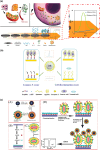Emerging Electrochemical Approaches for the Early Detection of Programmed Cell Death
- PMID: 40821520
- PMCID: PMC12355238
- DOI: 10.1021/acsomega.5c05652
Emerging Electrochemical Approaches for the Early Detection of Programmed Cell Death
Abstract
Programmed cell death (apoptosis) safeguards tissue homeostasis, and its dysregulation is a hallmark of cancer, neurodegeneration, and immune disorders. Detecting the earliest biochemical signatures of apoptosis therefore offers a route to sharper diagnosis, real-time therapy monitoring, and data-driven drug discovery. Electrochemical biosensors are uniquely suited to this task because they translate molecular recognition events into electrical signals that are rapid, miniaturizable, and inherently compatible with point-of-care formats. Yet their clinical translation is still limited by three persistent hurdles: (i) selective recognition in protein-rich or highly variable matrices, (ii) long-term signal stability under continuous operation, and (iii) a lack of unified analytical performance standards that hampers cross-platform benchmarking. This critical review charts the most recent material, biochemical, and microelectronic innovations that are beginning to erode these barriers, and identifies emerging strategiesfrom nanostructured electrode interfaces to signal processing that could propel electrochemical apoptosis sensing from proof-of-concept prototypes to reliable bedside tools. By aligning unresolved challenges with promising technological solutions, we aim to guide interdisciplinary efforts toward next-generation diagnostics capable of real-time apoptosis surveillance in complex biological settings.
© 2025 The Authors. Published by American Chemical Society.
Figures





References
-
- Hasanzadeh M., Shadjou N., de la Guardia M.. Early stage diagnosis of programmed cell death (apoptosis) using electroanalysis: Nanomaterial and methods overview. TrAC, Trends Anal. Chem. 2017;93:199–211. doi: 10.1016/j.trac.2017.06.007. - DOI
Publication types
LinkOut - more resources
Full Text Sources
